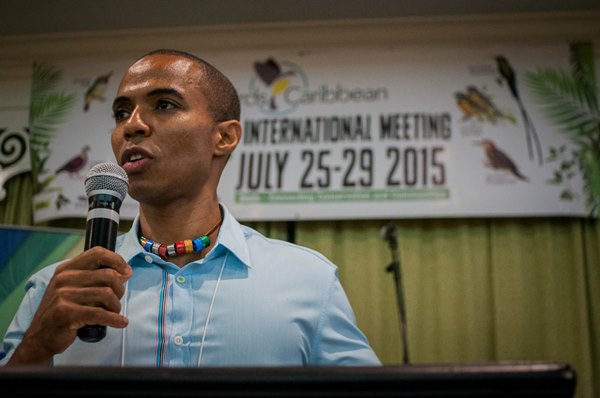August 6, 2015—Kingston, Jamaica—Every two years, bird educators, scientists and conservationists from throughout the Caribbean and beyond gather for BirdsCaribbean’s International Meeting. At this year’s meeting in Kingston, Jamaica, over 220 international and local delegates gathered to share the latest in Caribbean bird science, conservation and education. Birds—Connecting Communities and Conservation was the theme for the meeting, the largest conservation conference held in the entire Caribbean in recent years.
The conference opened with “Jamaica Day — A Celebration of Jamaica’s Unique and Wonderful Birds” which included a dozen presentations about Jamaica’s birds, from the latest research in tracking Jamaican seabird populations to the role of birds in pest control on Blue Mountain coffee farms. The extended look at Jamaica’s birds also included reports on the arrival of the Caribbean Birding Trail program to Jamaica and Jamaica’s historical contribution to ornithology.

(From left) BirdsCaribbean Executive Director Dr. Lisa Sorenson, Roshaun “Bay-C” Clarke, and Dr. Ann Sutton. (Photo by Leno Davis)
The meeting continued with a series of outstanding presentations from famous conservationists, who spoke on a wide range of topics including the importance of involving the community in bird conservation, why it is important to conserve birds, how photography can be used to influence hearts and minds and the importance of habitat restoration for birds and people. Workshop topics focused on capacity building and included fundraising, advocacy and the use of social media.
Other highlights of the meeting included the announcement of the rediscovery of the Black-capped Petrel on the island of Dominica and the launch of a new book: The Endemic Birds of Cuba by Nils Navarro. The week before the conference, 30 children enjoyed a summer camp all about birds at the Hope Zoo, and two dozen Jamaicans were trained as birding guides during the Caribbean Birding Trail’s Jamaica launch.
“This year was the perfect time to bring the BirdsCaribbean meeting back to Jamaica,” noted BirdsCaribbean President Leo Douglas. “The Blue and John Crow mountains were named a UNESCO World Heritage Site just weeks before the meeting, while the Goat Islands and Portland Bight Protected Area are currently facing the threat of development. At this moment Jamaica is in the spotlight, representing both the irreplaceable value of Caribbean natural heritage and its vulnerability.”

BirdsCaribbean President Leo Douglas welcomes international delegates from 33 nations. (Photo by Mark Yokoyama)
In addition to over 120 presentations, workshops and panel discussions, the delegates enjoyed a variety of field trips to explore Jamaica’s natural areas first-hand. Conference trips visited Hope Gardens, Goat Islands, Cockpit Country, western Portland Bight, Portland, and the Blue and John Crow Mountains National Park, amongst other destinations. Many meeting participants were particularly eager to catch a glimpse of some of the 29 bird species endemic to Jamaica that can be seen nowhere else in the world and all expressed their amazement at the richness of Jamaica’s biodiversity and landscape and the warm welcome they received.
Local support was crucial to the success of the meeting, with sponsorships and media support coming from the National Environment and Planning Agency, Knutsford Court Hotel, Sandals Foundation, Carib Cement, Island Car Rental, Jamaica National Building Society, Hope Gardens, Hope Zoo, Jamaica Conservation Development Trust, The Gleaner, BirdLife Jamaica, AV Concepts and LIME. International sponsors included the US Fish and Wildlife Service, US Forest Service International Programs, Royal Society for the Protection of Birds, Dutch Conservation Nature Alliance, Cornell Lab of Ornithology, Audubon, Rare Species Conservatory Foundation, International Fund for Animal Welfare, and Anguilla Nature Explorers/Birds in Paradise Tour. The meeting concluded with a banquet and awards ceremony featuring renowned dancehall artist and environmentalist Roshaun “Bay-C” Clarke of the band T.O.K., ending the conference on a musical high note.


